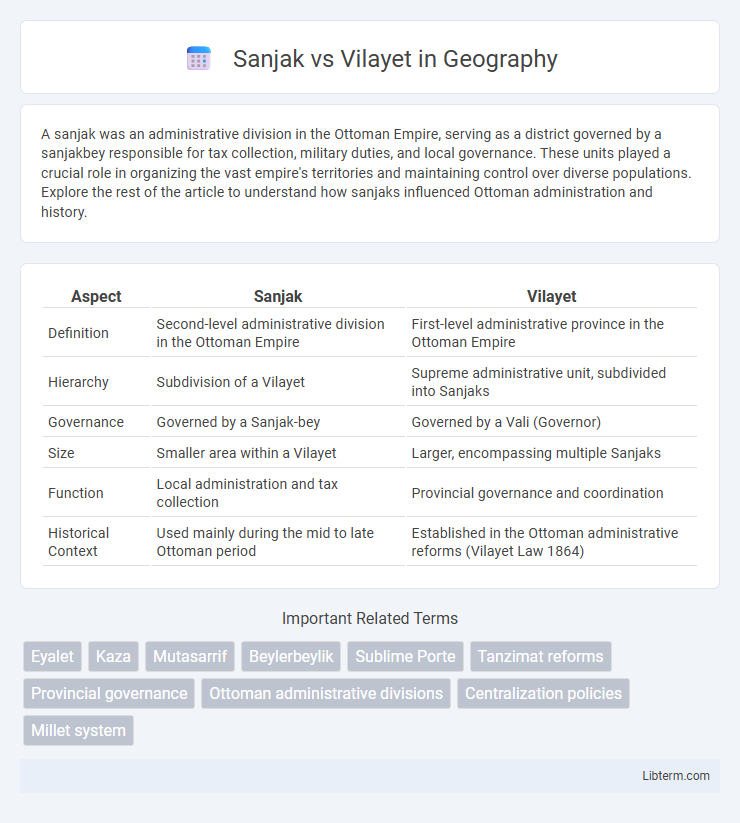A sanjak was an administrative division in the Ottoman Empire, serving as a district governed by a sanjakbey responsible for tax collection, military duties, and local governance. These units played a crucial role in organizing the vast empire's territories and maintaining control over diverse populations. Explore the rest of the article to understand how sanjaks influenced Ottoman administration and history.
Table of Comparison
| Aspect | Sanjak | Vilayet |
|---|---|---|
| Definition | Second-level administrative division in the Ottoman Empire | First-level administrative province in the Ottoman Empire |
| Hierarchy | Subdivision of a Vilayet | Supreme administrative unit, subdivided into Sanjaks |
| Governance | Governed by a Sanjak-bey | Governed by a Vali (Governor) |
| Size | Smaller area within a Vilayet | Larger, encompassing multiple Sanjaks |
| Function | Local administration and tax collection | Provincial governance and coordination |
| Historical Context | Used mainly during the mid to late Ottoman period | Established in the Ottoman administrative reforms (Vilayet Law 1864) |
Introduction to Ottoman Administrative Divisions
The Ottoman Empire's administrative divisions were primarily organized into Vilayets and Sanjaks, with Vilayets serving as larger provincial units governed by a Vali and further subdivided into Sanjaks, which were overseen by Sanjak-beys. Vilayets, established during the Tanzimat reform era in the mid-19th century, aimed to modernize and centralize administration, encompassing multiple Sanjaks to streamline governance. Sanjaks functioned as key local administrative districts responsible for tax collection, law enforcement, and military conscription within their territories.
Defining Sanjak: Structure and Function
A Sanjak was an administrative division within the Ottoman Empire, functioning as a district or sub-province governed by a Sanjak-bey. It served as an intermediate level between the Vilayet, the larger provincial unit, and smaller local entities, facilitating local governance, tax collection, and military organization. The Sanjak's structure enabled effective administrative control and regional coordination within the empire's vast territorial framework.
Understanding Vilayet: Role and Organization
A Vilayet served as a major administrative division in the Ottoman Empire, overseeing multiple Sanjaks within its jurisdiction to ensure centralized governance and efficient resource management. Each Vilayet was governed by a Vali, responsible for implementing state policies, maintaining law and order, and coordinating infrastructure development across its Sanjaks. This hierarchical organization allowed the Ottoman administration to balance local authority with imperial control, enhancing administrative cohesion and regional stability.
Historical Evolution of Sanjaks and Vilayets
Sanjaks were administrative districts in the Ottoman Empire established during the 14th century, serving as subdivisions of larger provinces called eyalets before the 19th-century reforms. The Vilayet system, introduced by the Vilayet Law of 1864, restructured these provinces into more centralized and standardized entities, replacing eyalets with vilayets governed by appointed officials. This reform aimed to improve administrative efficiency and governance by organizing sanjaks as second-level divisions within the new vilayet framework, reflecting the empire's modernization efforts.
Hierarchical Differences: Sanjak vs Vilayet
A Vilayet was a major administrative division in the Ottoman Empire, often encompassing multiple Sanjaks, which were smaller districts or counties. The Vilayet served as the primary provincial authority governed by a Vali, whereas Sanjaks were overseen by a Sanjakbey who reported to the Vali. The hierarchical structure positioned Vilayets at a higher administrative level, with Sanjaks functioning as subdivisions responsible for local governance within the Vilayet framework.
Governance and Administration Structures
Sanjaks functioned as sub-provincial districts within the Ottoman Empire, governed by a Sanjakbey responsible for local military and administrative duties, whereas Vilayets were larger provincial units led by a Vali with broader civil authority overseeing multiple sanjaks. Vilayet governance included a more complex bureaucratic system, comprised of provincial councils and specialized departments managing finance, justice, and public order, reflecting 19th-century Tanzimat reforms. Administrative decentralization in vilayets aimed to improve efficiency and central control compared to sanjak structures, which had more limited autonomy and simpler administrative setups.
Geographic Scope and Population Comparison
The Sanjak was a smaller administrative division within the Ottoman Empire, typically encompassing a district with a population ranging from tens of thousands to a few hundred thousand people, whereas the Vilayet was a larger province composed of several Sanjaks, often housing populations in the millions. Geographically, Vilayets covered extensive territories that could span entire regions or parts of multiple modern-day countries, while Sanjaks were limited to more localized areas and served as subunits for smoother governance. The population density and diversity within Vilayets were significantly greater compared to Sanjaks, reflecting their broader geographic scope and administrative importance.
Impact on Local Governance and Society
Sanjaks functioned as smaller administrative districts within Vilayets during the Ottoman Empire, allowing more localized governance and direct oversight of communities. Vilayets, as larger provincial units, centralized administrative control, influencing regional legal systems, tax collection, and infrastructure development across multiple Sanjaks. The hierarchical structure of Vilayets and Sanjaks shaped social organization, with Vilayets promoting broader provincial integration, while Sanjaks maintained closer ties to local customs and leadership.
Transition from Sanjaks to Vilayets
The transition from Sanjaks to Vilayets marked a significant administrative reform in the Ottoman Empire during the mid-19th century Tanzimat period, aiming to centralize and modernize governance. Sanjaks, smaller districts governed by a Sanjak-bey, were consolidated into larger Vilayets overseen by a vali, enhancing administrative efficiency and control. This reorganization facilitated improved tax collection, law enforcement, and infrastructure development within the empire.
Legacy of Sanjak and Vilayet in Modern Context
The Sanjak, a smaller administrative unit within the Ottoman Empire, served as a foundational model for modern district-level governance, influencing contemporary administrative boundaries in Turkey and Balkan nations. The Vilayet system, introduced in the mid-19th century Tanzimat reforms, established a more centralized provincial structure that laid groundwork for modern regional administration, promoting efficient bureaucratic control. Both Sanjak and Vilayet legacies persist in modern governance frameworks, reflecting Ottoman administrative practices in present-day provincial divisions and local government organization.
Sanjak Infographic

 libterm.com
libterm.com